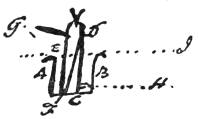To James Madison from the Right Reverend James Madison, [28 December] 1800
From the Right Reverend James Madison
[28 December 1800]
My dear Sir
I recd. your Favour from Richmond,1 & am greatly obliged for your friendly Information respecting the Land purchased by Mr Patton.2 I should have answered it sooner, but wished first to see the Result of some kind of Negotiation that had already been opened for Land not far from you. That appears now to be at an End; & if I could get that Part of Patton’s Purchase, which you have described upon equitable, or rather reasonable Terms, I think I should decide upon being your Neighbour; an Event which I ardently wish for. It is not true that I have relinquished the Hope of being still enabled to accomplish that Object; tho’ it is too true, that the late Insurrection has rendered Mrs. M. very averse to the Increase of the No. of our Slaves, which the Settlement of a Farm would make necessary. The Quantity & Quality of the Land you described, it’s Situation, & the Buildings upon it, are all great Objects. If you should meet with Mr Patton, I should be obliged to you to know of him, what are his Terms. I had a Thought of writing to him, & probably shall do so.
It would have been highly gratifying to us, if you & Mrs. Madison had extended your Journey thus far. When will the Time come, that you will find sufficient Leisure, sufficiently good Roads, & sufficient Resolution for such an Excursion? The last is the only Desideratum, & when another good Opportunity offers, we shall not readily forgive the Want of it.
You recollect the Water Bellows, which you spoke of when I was with you. Lately a Drawing of one has been sent to me. It is a most ingenious Application of Water to a new Purpose; & might be very advantageously, I should think, made Use of by your Smith, as he is so near to a small Stream. Yesterday, I made the Experiment with a few domestic Utensils, in order to determine, from whence the abundant Supply of air came. This you recollect was our Difficulty. The Result is, that the Air is seperated from the Water, as it falls against an oblique Board placed in the Air Chest, & not driven, or pressed into the Chest by the Fall of the Water thro’ the Atmosphere; for the Effect is the same, whether the Fall thro’ the Atmosphere be entirely prevented, or increased as high as a Man’s Head. This was my Apparatus.

I have just received from Rumford,3 a Pamphlet, containing the Charter, Laws, Object Etc of the royal, national Institution of G. Britain.4 It’s Object is the Improvement of all Kinds of Machines, & to promote the just Application of Philosophical Principles to useful Purposes. The ablest Men are engaged to give Lectures in natural Philos. & Chemistry. Our College is invited to assist in the laudable Object. You see how they tread in the Steps of French Genius. A Kind of Apology is made for the Name, & they say they took it from the Instituto, long established at Bologna.5
Will it not be a strange Vagary in Fortune to place Burr in the presidential Chair? I can hardly suppose such an Event possible; & yet so various are Reports, that I fear, our Friend Jefferson is not so sure of it, as America, or the great Majority of the People would have him to be.
RC (DLC). Addressed by Bishop Madison to JM in Orange County. Lower portion of second sheet, including complimentary close, signature, and date, has been clipped. Docketed by JM, 28 Dec. 1800. At a later time, JM added the following note: “The concluding paragraph was sent to the Revd. Mr. Sprague who requested an autograph of Bishop Madison” (see JM to William B. Sprague, 12 Dec. 1828 [draft, DLC]).
1. Letter not found.
2. Probably Robert Patton, a Fredericksburg merchant and land speculator, who advertised for sale 791 acres of land in Orange County, “about 12 miles from the Court House,” in June 1800 (Fredericksburg Va. Herald, 13 June 1800).
3. Benjamin Thompson, count of Rumford (1753–1814), was a Massachusetts-born Loyalist, soldier of fortune, and scientist, whose energy and abilities proved greater than his allegiance to any particular government. At one time or another in his career, Rumford sought his fortune in New Hampshire, Great Britain, Bavaria, and France. He was the founder of the Royal Institution of Great Britain, formed for the diffusion of scientific knowledge and the perfection of mechanical arts or, as Rumford wrote, to teach “the application of science to the useful purposes of life” (Sanborn C. Brown, Benjamin Thompson, Count Rumford [Cambridge, Mass., 1979], pp. 213–32).
4. Rumford’s Prospectus of the Royal Institution of Great Britain (London, 1800) was sent by the author to the presidents of “all the Universities, Academies, Colledges and other Scientific Bodies of note and respectability in the United States” (W. J. Sparrow, Knight of the White Eagle: A Biography of Sir Benjamin Thompson, Count Rumford [London, 1964], p. 120).
5. L’Istituto e l’Accademia delle Scienze di Bologna was one of the institutions created in the eighteenth century to examine and disseminate scientific discoveries (as was the Institut National de France). Probably its most famous member was Luigi Galvani, who also served for a time as its president (Walter Tega, “Mens agitat molem: L’Accademia delle Scienze di Bologna,” in Scienza e letteratura nella cultura italiana del Settecento, ed. Renzo Cremante and Walter Tega [Bologna, 1984], pp. 65–67).

![University of Virginia Press [link will open in a new window] University of Virginia Press](/lib/media/rotunda-white-on-blue.png)
